
Does gun ownership make you safer?
If you ask the general public, most Americans say it does. According to a new poll by NBC News and the Wall Street Journal, 58 percent of Americans agree with the statement that “[g]un ownership does more to increase safety by allowing law-abiding citizens to protect themselves.” In comparison, 38 percent agree with the statement that “[g]un ownership does more to reduce safety by giving too many people access to firearms and increasing the chances for accidental misuse.”
This is a shift from 1999, when 41 percent of Americans agreed with the first statement and 52 percent with the second.
But if you look at the research, it seems the majority from 1999 had the right idea: Gun ownership decreases safety — on both an individual and collective level.
Individually, several studies have found that the presence of a gun in a home elevates the risk of death. A 2014 review of the research published in the Annals of Internal Medicine, for instance, found that access to firearms was associated with a doubled risk for homicide and a tripled risk for suicide. A 2017 piece by Melinda Wenner Moyer in Scientific American also ran through the evidence, concluding that gun ownership was associated with a higher risk of homicide, suicide, and accidental shootings.
People often think that guns will potentially protect them from a home invader. But these kinds of events are relatively rare (and even then, the presence of a firearm can make it more likely that such a situation will escalate into deadly violence) — while the chances that a gun could be used to fatal ends in a domestic dispute, suicide, or accidental shooting are much higher, as the research on individual risk demonstrates.
This is true on a collective level as well: After controlling for other factors, higher levels of gun ownership are associated with higher levels of gun violence. Based on the research, this is one of the key reasons the US has much higher levels of gun violence than its developed peers.
More guns, more gun deaths
The US is unique in two key — and related — ways when it comes to guns: It has way more gun deaths than other developed nations, and it has far higher levels of gun ownership than any other country in the world.
The US has nearly six times the gun homicide rate of Canada, more than seven times that of Sweden, and nearly 16 times that of Germany, according to United Nations data compiled by the Guardian. (These gun deaths are a big reason America has a much higher overall homicide rate, which includes non-gun deaths, than other developed nations.)
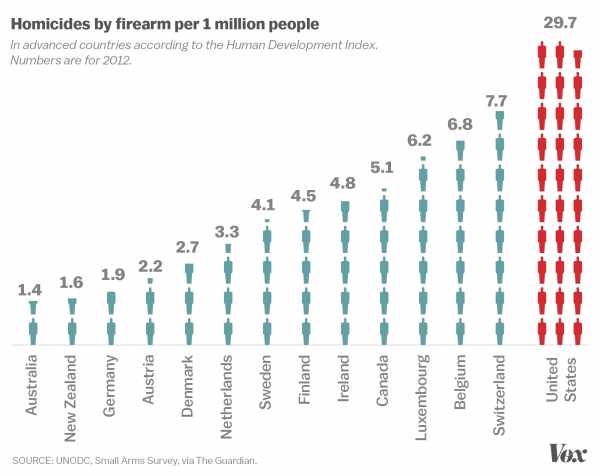

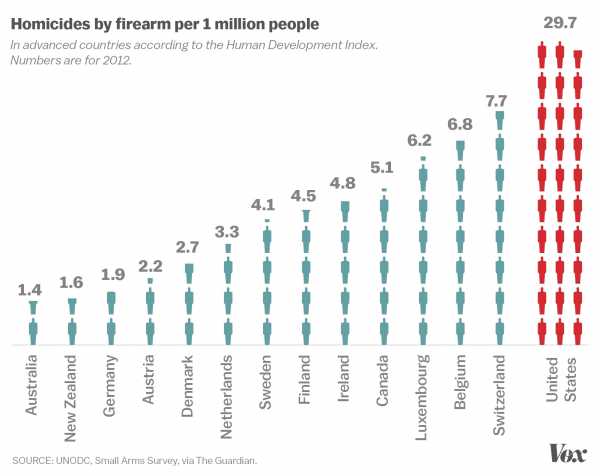
Mass shootings actually make up a small fraction of America’s gun deaths, constituting less than 2 percent of such deaths in 2013. But America does see a lot of these horrific events: According to CNN, “The US makes up less than 5% of the world’s population, but holds 31% of global mass shooters.”
The US also has by far the highest number of privately owned guns in the world. Estimated in 2007, the number of civilian-owned firearms in the US was 88.8 guns per 100 people, meaning there was almost one privately owned gun per American and more than one per American adult. The world’s second-ranked country was Yemen, a quasi-failed state torn by civil war, where there were 54.8 guns per 100 people.
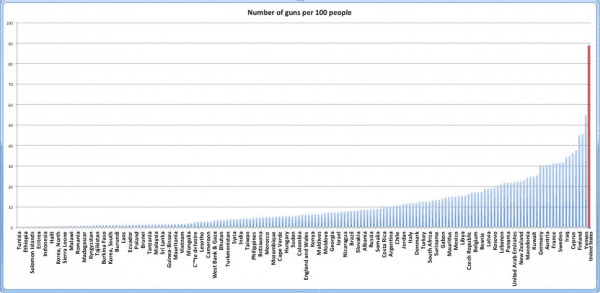

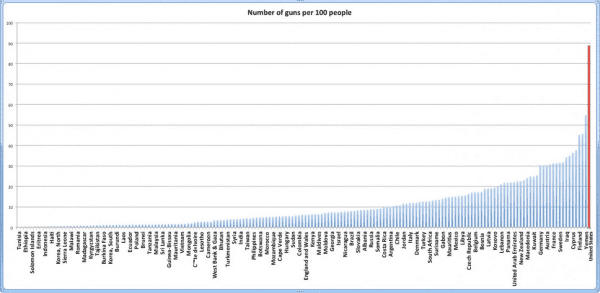
Another way of looking at that: Americans make up less than 5 percent of the world’s population yet own roughly 42 percent of all the world’s privately held firearms.
These two facts — on gun deaths and firearm ownership — are related. The research, compiled by the Harvard School of Public Health’s Injury Control Research Center, is pretty clear: After controlling for variables such as socioeconomic factors and other crime, places with more guns have more gun deaths.
“Within the United States, a wide array of empirical evidence indicates that more guns in a community leads to more homicide,” David Hemenway, the Injury Control Research Center’s director, wrote in Private Guns, Public Health.
For example, a 2013 study, led by a Boston University School of Public Health researcher, found that, after controlling for multiple variables, a 1 percent increase in gun ownership correlated with a roughly 0.9 percent rise in the firearm homicide rate at the state level.
This chart, based on data compiled by researcher Josh Tewksbury, shows the correlation between the number of guns and gun deaths among wealthier nations:
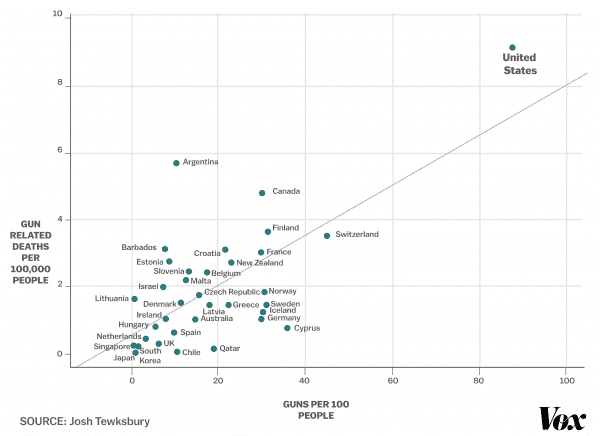

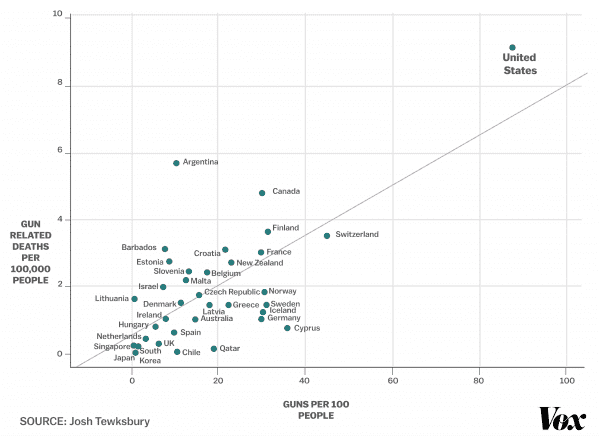
Guns are not the only contributor to violence. (Other factors include, for example, poverty, urbanization, and alcohol consumption.) But when researchers control for other confounding variables, they have found time and time again that America’s high levels of gun ownership are a major reason the US is so much worse in terms of gun violence than its developed peers.
As a breakthrough analysis by UC Berkeley’s Franklin Zimring and Gordon Hawkins in 1999 found, it’s not even that the US has more crime than other developed countries. This chart, based on data from Jeffrey Swanson at Duke University, shows that the US is not an outlier when it comes to overall crime:
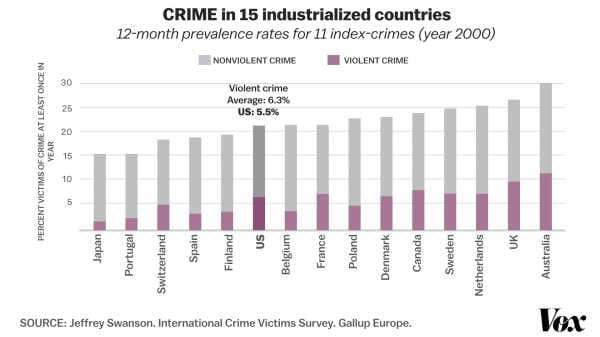

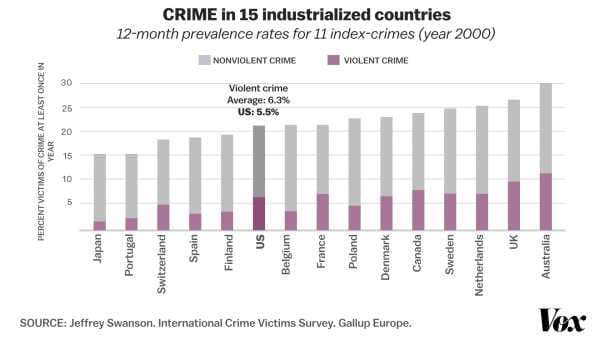
Instead, the US appears to have more lethal violence — and that’s driven in large part by the prevalence of guns.
”A series of specific comparisons of the death rates from property crime and assault in New York City and London show how enormous differences in death risk can be explained even while general patterns are similar,” Zimring and Hawkins wrote. “A preference for crimes of personal force and the willingness and ability to use guns in robbery make similar levels of property crime 54 times as deadly in New York City as in London.”
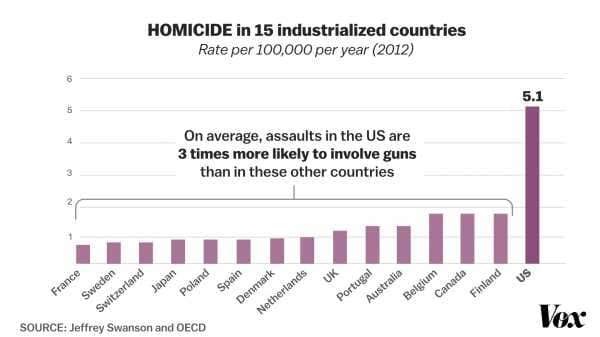

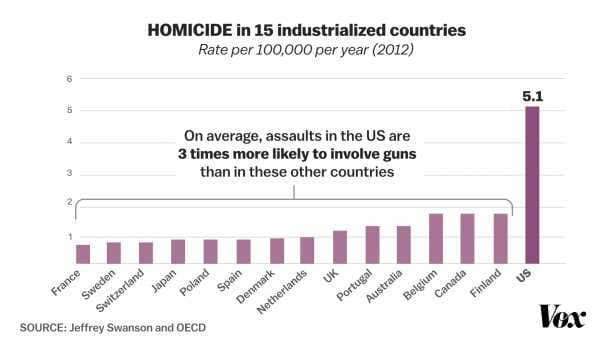
This is in many ways intuitive: People of every country get into arguments and fights with friends, family, and peers. But in the US, it’s much more likely that someone will get angry at an argument and be able to pull out a gun and kill someone.
Meanwhile, the research suggests that restricting access to guns helps reduce violence. A 2016 review of 130 studies in 10 countries, published in Epidemiologic Reviews, found that new legal restrictions on owning and purchasing guns tended to be followed by a drop in gun violence — a strong indicator that restricting access to firearms can save lives.
And a recent review of the best US-based studies by the RAND Corporation suggested that, while much of the research is lacking, there is evidence that some gun control measures — background checks, child access prevention laws, minimum age requirements, and prohibitions associated with mental illness — are linked to reductions in injuries and deaths.
All of this suggests that gun ownership does not increase safety — and is instead a key reason that America suffers so much gun violence compared to its developed peers.
For more on gun violence in America, read Vox’s explainer.
Sourse: vox.com






